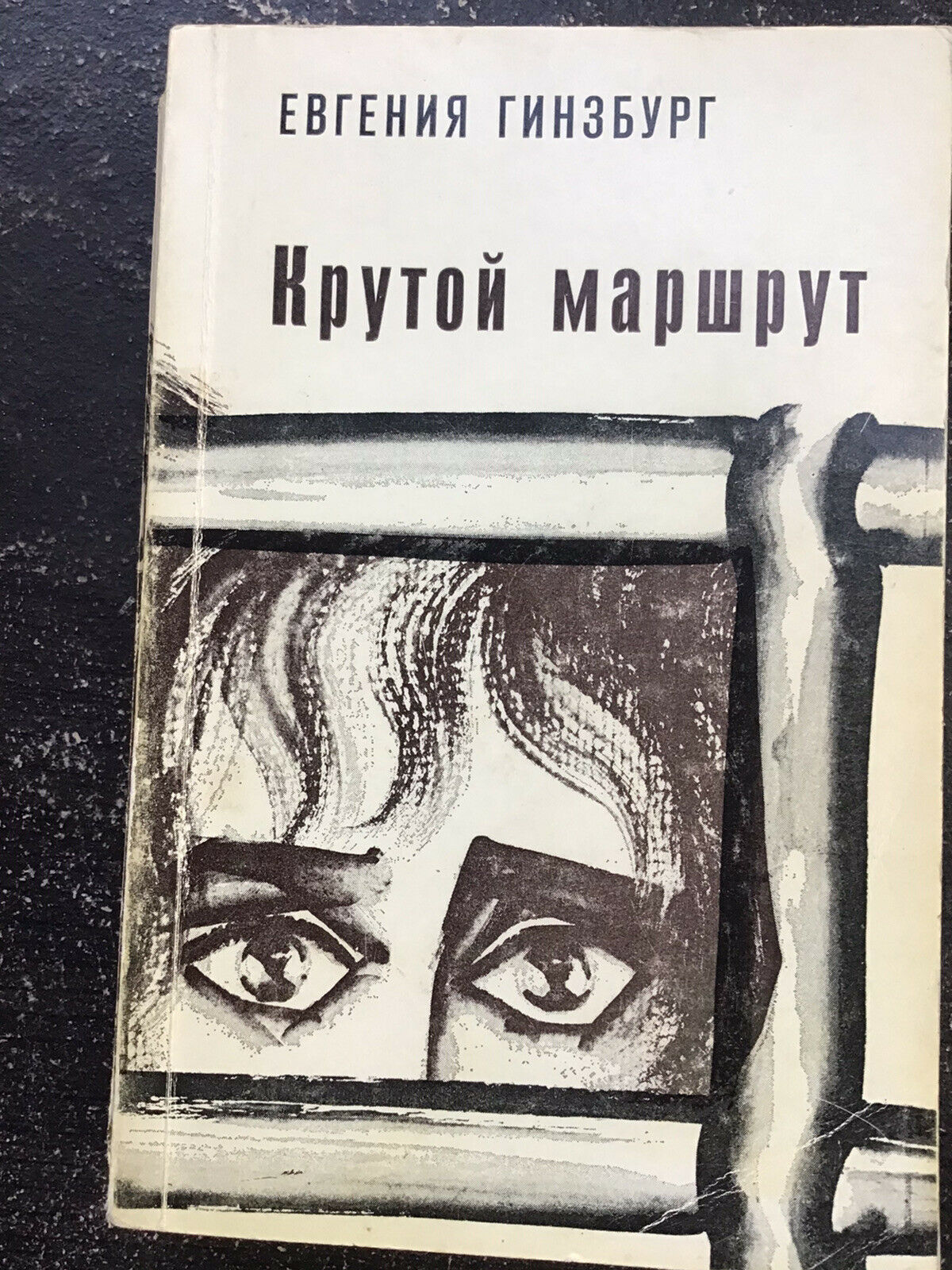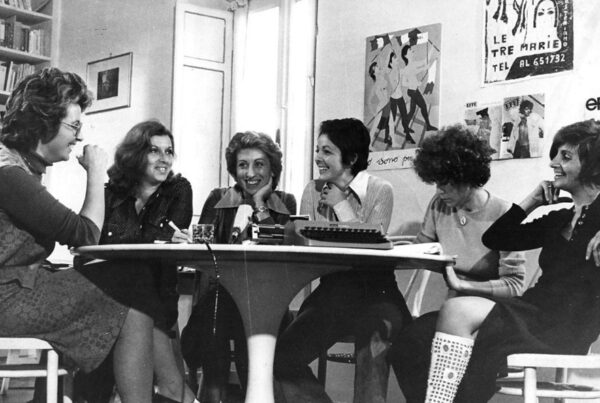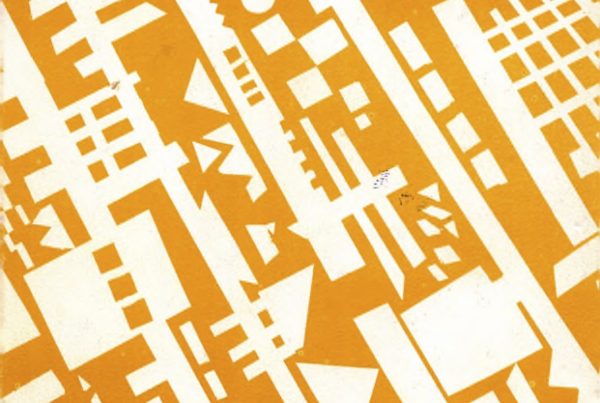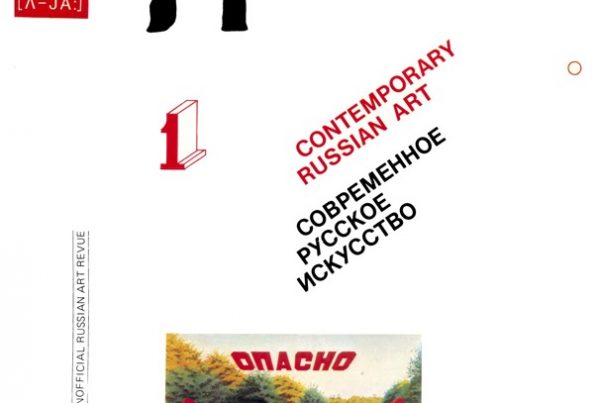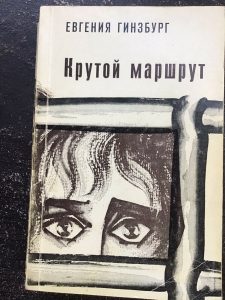
Cover of the Russian edition of ‘”Krutoi marshrut” (Posev, 1968).
Title:
Krutoi marshrut. Khronika vremen kul’ta lichnosti [Journey into the Whirlwind. Chronicle of the times of the cult of personality]
Author: Evgeniia Semenovna Ginzburg (1904-1977)
Year of writing: (1937-55) 1959-1962 (first volume); 1967-1977 (second volume)
Year of first publication: 1967 (first volume); 1979 (second volume)
Publisher: Mondadori
Place of publication: Milan
Description:
In her autobiographical novel and memoir – Krutoi marshrut – Evgeniia Ginzburg wrote that her first life ended in 1937, when she fell victim to the Stalinist purges and was arrested on charges of terrorist activity and participation in anti-Soviet and counter-revolutionary organisations, according to paragraphs 8 and 11 of the infamous Article 58 of the Criminal Code of the Russian Soviet Federative Socialist Republic (RSFSR). At the time of her arrest, Evgeniia Semenovna, who had taught history of the Bolshevik Communist Party at the University of Kazan (1933-35), was working in the editorial office of the regional newspaper “Krasnaia Tatariia” (Red Tatary) as editor of its cultural page. The story of her life from that day was forged by the various Soviet prisons and lagers she was sent to (Lefortovo, Butyrka, Iaroslavl’ penitentiary, Vladivostokskii lager’, Ėl’genskii lager’, Magadanskii lager’, Severnyi lager’, Taskanskii lager’). The author described this period as “a dead woman’s wanderings in hell” and marked the date and time of her damnation as two o’clock on 15th February 1937. The beginning of her tragedy, like that of many other intellectuals and citizens loyal to Soviet power dates back to 1934, the year in which Sergei Kirov was assassinated and the persecution of the so-called “enemies of the people” intensified. The assassination of Kirov initiated new waves of repression culminating in the great purges (1936-38), which did not spare even prominent members and leaders of the CPSU. Evgeniia Ginzburg and her husband Pavel Vasil’evich Aksënov, president of the city Soviet of Kazan’ workers’ deputies, were among the first targets of the various waves of chistki (purges). When they were both arrested a few months apart, they had two sons, Aleksei and Vasilii, the latter of whom went on to become an internationally renowned writer, author of the novel Zvëzdnyi bilet, (The Starry Ticket, 1961) and editor – together with A. Bitov, V. Erofeev, F. Iskander and E. Popov – of the famous literary almanac MetrOpol’, published in samizdat in 1979.
Krutoi marshrut is a journey into the hell of the Soviet prison system, describing its brutality, the methodical annihilation of the prisoners’ will, dignity and identity, and the hard struggle for physical, moral and psychological survival. In her experience as a prisoner, Ginzburg went through all the stages of the tortuous path towards an unexpected freedom that she finally obtained in 1955: expulsion from the party, arrest, interrogation, torture, solitary confinement, summary trial, and a ten-year sentence of hard labour. She was first released from prison in 1947 and then arrested again in 1949, during the wave of repression after the Second World War. In 1950, she was sentenced to internment, first in the Krasnoiarsk region and then in Kolima. Rehabilitated in 1955, she was only able to return to her native Moscow in 1966. Her story is interwoven with the voices, almost all female, of her fellow prisoners, who enrich the narrative, transforming it into an account of an atrocious collective experience (cf. Clemente 2013). In this way, the work transcends the individual dimension of other memoirs to become a choral testimony of a vast concentrationary universe, helping to delineate new terrible routes on the map of the Gulag archipelago illustrated by Solzhenitsyn.
The first part of the work was written from 1959 onwards, although Ginzburg has often declared that composition began the day after her imprisonment because she succeeded in fixing a large number of passages in her mind with the aim of preserving a detailed memory of her own experience in prison and that of her cell and barrack mates. Keeping the memory of everything that happened around her in order to be able to recount it later became the sole aim that engaged the author during the 18 long years of her sentence. The verses she retained, became a canvas for her writing. This method, widely adopted by prisoners who were unable to put their memories down on paper, was also used by Ol’ga Adamova-Sliozberg when writing Put’ (The Way) and by Solzhenitsyn himself. The writing of the first part of the work was completed in 1962, when Evgeniia Semennovna tried to have it published in various Soviet magazines – including the liberal “Junost'” and “Novyi Mir”, among the most sensitive to the new literature of the so-called first Thaw (1956-62) – persuaded by the idea that, after the publication of Solzhenitsyn’s Odin den’ Ivana Denisovicha (One Day in the Life of Ivan Denisovich) in the “Novyi Mir” edited by A. Tvardovskii (1962), the time was ripe for her own work to be printed (cf. Bit-Iunan Mitiushova 2015). But the Khrushchev Thaw was an ambiguous period, characterised by a partial and instrumental liberalisation of the arts, which resulted in alternating phases of openings and new closures. Ginzburg’s hopes were therefore dashed and Krutoi marshrut, after being rejected by the official magazines, began to circulate clandestinely in the Soviet underground, thanks to the channels of the samizdat. It was in this unofficial form that the manuscript reached Italy through the mediation of Alberto Sandretti who, as a student at Moscow State University (MGU) at the time, managed to obtain a copy and send it to Vittorio Sereni, literary director of the Arnoldo Mondadori publishing house in Milan. The Italian translation – by Sandretti himself and a colleague of his from the MGU in Moscow, Dino Bernardini, who used the collective pseudonym Aldino Betti – was therefore made from a non-authorial copy of the work and published by the Milanese publishing house without Ginzburg’s knowledge (cf. Parisi 2012-13: 79-80). The unexpected publication of Krutoi marshrut in Milan took the author by surprise. Some time later she complained that she had lost all control over her work, which was now living a life of its own not only in the Soviet underground, but also in the official publishing industry abroad, where Soviet works leaked clandestinely from the USSR (tamizdat) were increasingly being printed. The author not only regretted not being able to correct the proofs and participate in the publication of the book, but also worried about her own fate, since, just one year earlier (1966), A. Siniavskii and Iu. Daniel’ had been sentenced to hard labour for publishing their works abroad. Therefore, Ginzburg, fearing a new sentence, took care to disavow the Mondadori edition by giving an interview to “l’Unità” (1st June 1967, cf. Parisi 2012-13: 82-83).
The volume published by Mondadori – consisting of the first part and some fragments of the second part – was also published in Russian by the same publishing house in an edition which suffered from a lack of cooperation with the author and contained many inaccuracies, typos and errors. Writing in the Russian emigration magazine, “Russkaia mysl'” (13th July 1967), Nikolai Belov’s expressed his preference for the more accurate publication of fragments published the same year in “Grani” (N. 64-68, cf. Belov 1967). In 1967, “Posev” also published some fragments in Russian (17th February, 10 March) and an English translation was published by Harcourt Publishing House in New York. The following year a Russian version was published by Possev-Verlag in Frankfurt. In 1979, the second part of Krutoi marshrut, after being rejected by the Soviet state publishing house Gosizdat, was published both in an Italian translation (by Giovanni Buttafava and edited by Sergio Rapetti) and in Russian by Mondadori, this time with the consent of the author who had the opportunity to revise the draft and make corrections (cf. Parisi 2012-13: 85). The first Soviet publication of the work dates to the years of Gorbachëv’s perestroika, when an unabridged version appeared between 1988 and 1989 in the magazine “Daugava” (Nos. 7-12, 1988; Nos. 1-6, 1989) and a fragment was published in the magazine “Iunost'” (No. 9, 1988). In the USSR, the first complete edition of the work was published in three volumes in 1989 by the Kursiv publishing house in Saratov, with a print run of 50,000 copies. In the same year, the Sovremennik Theatre in Moscow staged the play Krutoi marshrut directed by Galina Volchek, a ten-year success that is still part of the theatre’s seasonal programme. During the Soviet era, two other Russian editions of the opera were published, one in 1990 and the other in 1991, respectively by the Moscow publishing houses Sovetskii pisatel’ and Kniga, both with a print run of 100,000 copies.
Ilaria Sicari
[30th June 2021]
Translation by Cecilia Martino
Editions in Russian
- Ginzburg E., Krutoi marshrut. Khronika vremeni kul’ta lichnosti, t. 1, Mondadori, Milan 1967.
- Ginzburg E., Krutoi marshrut, “Posev”, 17 fevr., 24 fevr., 3 mar., 10 mar. (1967).
- Ginzburg Je., Krutoi marshrut, “Grani”, 64-66 (1967); 67-68 (1968).
- Ginzburg E., Krutoi marshrut, Possev-Verlag, Frankfurt 1968.
- Ginzburg E., Krutoi marshrut. Khronika vremeni kul’ta lichnosti, t. 2, Mondadori, Milano 1979.
- Ginzburg E., Krutoi marshrut. Khronika vremeni kul’ta lichnosti, “Daugava”, 7-12 (1988); 1-6 (1989).
- Ginzburg E., Krutoj maršrut: fragment, “Junost’”, 9 (1988).
- Ginzburg E., Krutoi marshrut. Khronika vremeni kul’ta lichnosti, Kursiv, Saratov 1989.
- Ginzburg E., Krutoi marshrut. Khronika vremeni kul’ta lichnosti, Sovetskij pisatel’, Moskva 1990.
- Ginzburg E., Krutoi marshrut. Khronika vremeni kul’ta lichnosti, Kniga, Moskva 1991.
- Ginzburg E., Krutoi marshrut. Khronika vremeni kul’ta lichnosti, Rusič, Smolensk 1998.
- Ginzburg E., Krutoi marshrut. Khronika vremeni kul’ta lichnosti, AST-Astrel’, Moskva 2008.
- Ginzburg E., Krutoi marshrut. Khronika vremeni kul’ta lichnosti, AST-Astrel’, Moskva 2008.
- Ginzburg E., Krutoi marshrut. Khronika vremeni kul’ta lichnosti, AST-Astrel’, Moskva 2010.
- Ginzburg E., Krutoi marshrut. Khronika vremeni kul’ta lichnosti, AST-Astrel’, Moskva 2011.
- Ginzburg E., Krutoi marshrut. Khronika vremeni kul’ta lichnosti, AST, Moskva 2016.
Translations
- Ginzburg E., Viaggio nella vertigine, it. trans. A. Betti, Mondadori, Milano 1967.
- Ginzburg E., Journey into the Whirlwind, en. trans. Paul Stevenson and Max Hayward, Harcourt Inc., New York 1967.
- Ginsburg Je., Marschroute eines Lebens, Rowohlt Verlag, Reinbek bei Hamburg 1967.
- Guinzbourg E., Le vertige: Chronique des temps du culte de la personalité, t. 1, fr. trans. B. Abbots, J. Marie, Editions du Seuil, Paris 1967.
- Ginzburg E., Viaggio nella vertigine, vol. 2, it. trans. G. Buttafava, Mondadori, Milano 1979.
- Guinzbourg E., Le ciel de la Kolyma, t. 2, Editions du Seuil, Paris, 1980.
- Ginsburg Je, Gratwanderung, vol. 2, Piper, München 1980.
- Ginzburg E., Within the Whirlwind, trans. I. Boland, intr. H. Böll, Harvest book, Fort Washington 1982.
Bibliography
- Belov N., Vtoraia zhizn’ Evgenii Ginzburga, “Russkaia mysl’”, 13th July 1967, http://tamizdatproject.org/ru/reviews/nikolai-belov-second-life-evgenia-ginzburg, online (last accessed: 30/06/2021).
- Bit-Iunan Iu., Mitiushova A., Meždu «Novym Mirom» i «Posevom»: k sud’be zapreshchënnykh proizvedenii E. S. Ginzburg i V. S. Grossmana, “Vestnik RGGU”, Seriia “Istoriia. Filologiia. Vostokovedenie”, 5 (2015): 61-72 https://cyberleninka.ru/article/n/mezhdu-novym-mirom-i-posevom-k-sudbe-zapreschennyh-proizvedeniy-e-s-ginzburg-i-v-s-grossman, online (last accessed: 30/06/2021).
- Clemente F., Il Viaggio nella vertigine di Evgenija Ginzburg, “D.E.P. Deportate, esuli, profughe”, 22 (2013): 21-35, https://www.unive.it/pag/fileadmin/user_upload/dipartimenti/DSLCC/documenti/DEP/numeri/n22/03_22__maggio2013_-_Clemente.pdf, online (last accessed: 30/06/2021).
- Kopelev L., Orlova R., Evgeniia Ginzburg v kontse krutogo marshruta (posleslovie), in E. Ginzburg, Krutoi marshrut: Khronika vremen kul’ta lichnosti, Kursiv, Riga 1989: 311-345, https://www.sakharov-center.ru/asfcd/auth/?t=page&num=12578, online (last accessed: 30/06/2021).
- Parisi V., Da Magadan a Milano. Viaggio nella vertigine di Evgenija Ginzburg come esempio di socializzazione transnazionale dei testi, “eSamizdat”, IX (2012-13): 77-85, https://www.esamizdat.it/ojs/index.php/eS/issue/view/4, online (last accessed: 30/06/2021).
- Pieralli C., La lirica nella zona: poesia femminile nei GULag staliniani e nelle carceri, in A. Alberti, G. Moracci (eds.), Linee di confine. Separazioni e processi di integrazione nello spazio culturale slavo, Firenze UP, Firenze 2013: 221-246.
- Vasil’ev E., Evgeniia Solomonovna (Semënovna) Ginzburg, in N. Skatov (ed.), Russkaia literatura XX veka. Prosaiki, poėty, dramaturgi. Bibliograficheskii slovar’, t. 1, OLMA-PRESS Invest, Moskva 2005: 478-480, http://hrono.ru/biograf/bio_g/ginzburg_es.php, online (last accessed: 30/06/2021).
To cite this article:
Ilaria Sicari, Journey into the Whirlwind (E. Ginzburg), in Voci libere in URSS. Letteratura, pensiero, arti indipendenti in Unione Sovietica e gli echi in Occidente (1953-1991), a cura di C. Pieralli, M. Sabbatini, Firenze University Press, Firenze 2021-, <vocilibereurss.fupress.net>.
eISBN 978-88-5518-463-2
© 2021 Author(s)
Content license: CC BY 4.0
